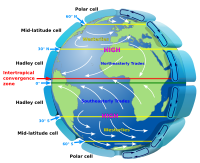
Photo from wikipedia
Springs offer insight into the sources and mechanisms of groundwater recharge and can be used to characterize fluid migration during earthquakes. However, few reports provide sufficient annual hydrochemical and isotopic… Click to show full abstract
Springs offer insight into the sources and mechanisms of groundwater recharge and can be used to characterize fluid migration during earthquakes. However, few reports provide sufficient annual hydrochemical and isotopic data to compare the variation characteristics and mechanisms with both atmospheric temperature and seismic effects. In this study, we used continuous δ2H, δ18O, and major ion data from four springs over 1 year to understand the groundwater origin, recharge sources, circulation characteristics, and coupling relationships with atmospheric temperature and earthquakes. We found that (1) atmospheric temperatures above and below 0 °C can cause significant changes in ion concentrations and water circulation depth, resulting in the mixing of fresh and old water in the aquifer, but it cannot cause changes in δ2H and δ18O. (2) Earthquakes of magnitude ≥ 4.8 within a 66 km epicentral distance can alter fault zone characteristics (e.g., permeability) and aggravate water–rock reactions, resulting in significant changes in δ2H, δ18O, and hydrochemical ion concentrations. (3) Hydrogen and oxygen isotopes are the most sensitive precursory seismic indicators. The results of this study offer a reference for the establishment of long-term hydrochemical and isotopic monitoring, with the potential for use in earthquake forecasting.
Journal Title: International Journal of Environmental Research and Public Health
Year Published: 2022
Link to full text (if available)
Share on Social Media: Sign Up to like & get
recommendations!